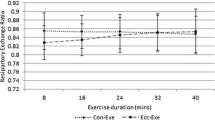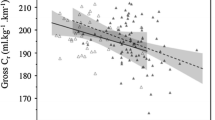Abstract
This study aimed to quantitatively describe and compare whole-body fat oxidation kinetics in cycling and running using a sinusoidal mathematical model (SIN). Thirteen moderately trained individuals (7 men and 6 women) performed two graded exercise tests, with 3-min stages and 1 km h−1 (or 20 W) increment, on a treadmill and on a cycle ergometer. Fat oxidation rates were determined using indirect calorimetry and plotted as a function of exercise intensity. The SIN model, which includes three independent variables (dilatation, symmetry and translation) that account for main quantitative characteristics of kinetics, provided a mathematical description of fat oxidation kinetics and allowed for determination of the intensity (Fatmax) that elicits maximal fat oxidation (MFO). While the mean fat oxidation kinetics in cycling formed a symmetric parabolic curve, the mean kinetics during running was characterized by a greater dilatation (i.e., widening of the curve, P < 0.001) and a rightward asymmetry (i.e., shift of the peak of the curve to higher intensities, P = 0.01). Fatmax was significantly higher in running compared with cycling (P < 0.001), whereas MFO was not significantly different between modes of exercise (P = 0.36). This study showed that the whole-body fat oxidation kinetics during running was characterized by a greater dilatation and a rightward asymmetry compared with cycling. The greater dilatation may be mainly related to the larger muscle mass involved in running while the rightward asymmetry may be induced by the specific type of muscle contraction.



Similar content being viewed by others
References
Achten J, Gleeson M, Jeukendrup AE (2002) Determination of the exercise intensity that elicits maximal fat oxidation. Med Sci Sports Exerc 34:92–97
Achten J, Venables MC, Jeukendrup AE (2003) Fat oxidation rates are higher during running compared with cycling over a wide range of intensities. Metabolism 52:747–752
Arkinstall MJ, Bruce CR, Nikolopoulos V, Garnham AP, Hawley JA (2001) Effect of carbohydrate ingestion on metabolism during running and cycling. J Appl Physiol 91:2125–2134
Baecke JA, Burema J, Frijters JE (1982) A short questionnaire for the measurement of habitual physical activity in epidemiological studies. Am J Clin Nutr 36:936–942
Basset FA, Boulay MR (2000) Specificity of treadmill and cycle ergometer tests in triathletes, runners and cyclists. Eur J Appl Physiol 81:214–221
Beaver WL, Wasserman K, Whipp BJ (1986) A new method for detecting anaerobic threshold by gas exchange. J Appl Physiol 60:2020–2027
Bergman BC, Brooks GA (1999) Respiratory gas-exchange ratios during graded exercise in fed and fasted trained and untrained men. J Appl Physiol 86:479–487
Bergman BC, Butterfield GE, Wolfel EE, Casazza GA, Lopaschuk GD, Brooks GA (1999) Evaluation of exercise and training on muscle lipid metabolism. Am J Physiol 276:E106–E117
Bijker KE, de Groot G, Hollander AP (2002) Differences in leg muscle activity during running and cycling in humans. Eur J Appl Physiol 87:556–561
Billat VL, Richard R, Binsse VM, Koralsztein JP, Haouzi P (1998) The V(O2) slow component for severe exercise depends on type of exercise and is not correlated with time to fatigue. J Appl Physiol 85:2118–2124
Carter J, Jeukendrup AE (2002) Validity and reliability of three commercially available breath-by-breath respiratory systems. Eur J Appl Physiol 86:435–441
Carter H, Jones AM, Barstow TJ, Burnley M, Williams CA, Doust JH (2000) Oxygen uptake kinetics in treadmill running and cycle ergometry: a comparison. J Appl Physiol 89:899–907
Carter SL, Rennie C, Tarnopolsky MA (2001) Substrate utilization during endurance exercise in men and women after endurance training. Am J Physiol Endocrinol Metab 280:E898–E907
Cavagna GA (1977) Storage and utilization of elastic energy in skeletal muscle. Exerc Sport Sci Rev 5:89–129
Cheneviere X, Borrani F, Ebenegger V, Gojanovic B, Malatesta D (2009a) Effect of a 1-hour single bout of moderate-intensity exercise on fat oxidation kinetics. Metabolism 58:1778–1786
Cheneviere X, Malatesta D, Peters EM, Borrani F (2009b) A mathematical model to describe fat oxidation kinetics during graded exercise. Med Sci Sports Exerc 41:1615–1625
Coyle EF, Jeukendrup AE, Oseto MC, Hodgkinson BJ, Zderic TW (2001) Low-fat diet alters intramuscular substrates and reduces lipolysis and fat oxidation during exercise. Am J Physiol Endocrinol Metab 280:E391–E398
Durnin JV, Womersley J (1973) Total body fat, calculated from body density, and its relationship to skinfold thickness in 571 people aged 12–72 years. Proc Nutr Soc 32:45A
Frayn KN (1983) Calculation of substrate oxidation rates in vivo from gaseous exchange. J Appl Physiol 55:628–634
Hermansen L, Saltin B (1969) Oxygen uptake during maximal treadmill and bicycle exercise. J Appl Physiol 26:31–37
Horton TJ, Pagliassotti MJ, Hobbs K, Hill JO (1998) Fuel metabolism in men and women during and after long-duration exercise. J Appl Physiol 85:1823–1832
Horton TJ, Miller EK, Glueck D, Tench K (2002) No effect of menstrual cycle phase on glucose kinetics and fuel oxidation during moderate-intensity exercise. Am J Physiol Endocrinol Metab 282:E752–E762
Knechtle B, Muller G, Willmann F, Kotteck K, Eser P, Knecht H (2004) Fat oxidation in men and women endurance athletes in running and cycling. Int J Sports Med 25:38–44
Koyal SN, Whipp BJ, Huntsman D, Bray GA, Wasserman K (1976) Ventilatory responses to the metabolic acidosis of treadmill and cycle ergometry. J Appl Physiol 40:864–867
Midgley AW, Bentley DJ, Luttikholt H, McNaughton LR, Millet GP (2008) Challenging a dogma of exercise physiology: does an incremental exercise test for valid VO2max determination really need to last between 8 and 12 minutes? Sports Med 38:441–447
Nieman DC, Nehlsen-Cannarella SL, Fagoaga OR, Henson DA, Utter A, Davis JM, Williams F, Butterworth DE (1998) Effects of mode and carbohydrate on the granulocyte and monocyte response to intensive, prolonged exercise. J Appl Physiol 84:1252–1259
Nordby P, Saltin B, Helge JW (2006) Whole-body fat oxidation determined by graded exercise and indirect calorimetry: a role for muscle oxidative capacity? Scand J Med Sci Sports 16:209–214
Perez-Martin A, Dumortier M, Raynaud E, Brun JF, Fedou C, Bringer J, Mercier J (2001) Balance of substrate oxidation during submaximal exercise in lean and obese people. Diabetes Metab 27:466–474
Romijn JA, Coyle EF, Sidossis LS, Gastaldelli A, Horowitz JF, Endert E, Wolfe RR (1993) Regulation of endogenous fat and carbohydrate metabolism in relation to exercise intensity and duration. Am J Physiol 265:E380–E391
Sidossis LS, Wolfe RR, Coggan AR (1998) Regulation of fatty acid oxidation in untrained vs. trained men during exercise. Am J Physiol 274:E510–E515
Snyder AC, O’Hagan KP, Clifford PS, Hoffman MD, Foster C (1993) Exercise responses to in-line skating: comparisons to running and cycling. Int J Sports Med 14:38–42
Starritt EC, Howlett RA, Heigenhauser GJ, Spriet LL (2000) Sensitivity of CPT I to malonyl-CoA in trained and untrained human skeletal muscle. Am J Physiol Endocrinol Metab 278:E462–E468
Stisen AB, Stougaard O, Langfort J, Helge JW, Sahlin K, Madsen K (2006) Maximal fat oxidation rates in endurance trained and untrained women. Eur J Appl Physiol 98:497–506
van Loon LJ, Greenhaff PL, Constantin-Teodosiu D, Saris WH, Wagenmakers AJ (2001) The effects of increasing exercise intensity on muscle fuel utilisation in humans. J Physiol 536:295–304
Venables MC, Achten J, Jeukendrup AE (2005) Determinants of fat oxidation during exercise in healthy men and women: a cross-sectional study. J Appl Physiol 98:160–167
Wasserman K, Hansen JE, Sue AY, Whipp BJ, Casaburi R (1994) Principles of exercise testing and interpretation, Second edn. Lippincott Williams & Wilkins, Philadelphia
Whipp BJ, Rossiter HB (2005) The kinetics of oxygen uptake: physiological inferences from the parameters. In: Jones AM, Poole DC (eds) Oxygen uptake kinetics in sport exercise and medicine. Routledge, London, pp 62–93
Zderic TW, Coggan AR, Ruby BC (2001) Glucose kinetics and substrate oxidation during exercise in the follicular and luteal phases. J Appl Physiol 90:447–453
Author information
Authors and Affiliations
Corresponding author
Additional information
Communicated by Klaas Westerterp.
This article is published as part of the Special Issue dedicated to Pietro di Prampero, formerly Editor-in-Chief of EJAP.
Rights and permissions
About this article
Cite this article
Chenevière, X., Malatesta, D., Gojanovic, B. et al. Differences in whole-body fat oxidation kinetics between cycling and running. Eur J Appl Physiol 109, 1037–1045 (2010). https://doi.org/10.1007/s00421-010-1443-5
Accepted:
Published:
Issue Date:
DOI: https://doi.org/10.1007/s00421-010-1443-5




